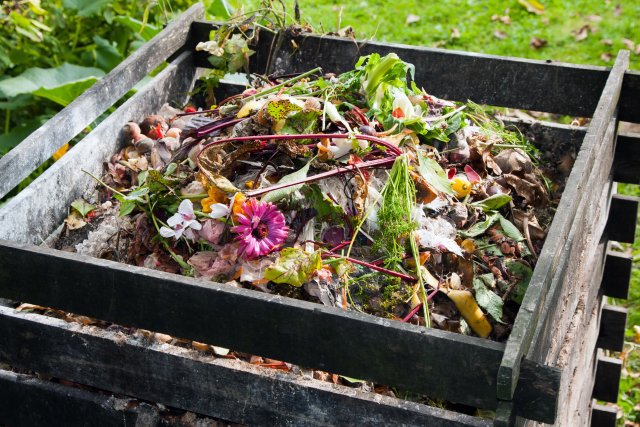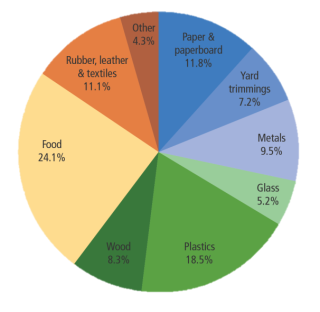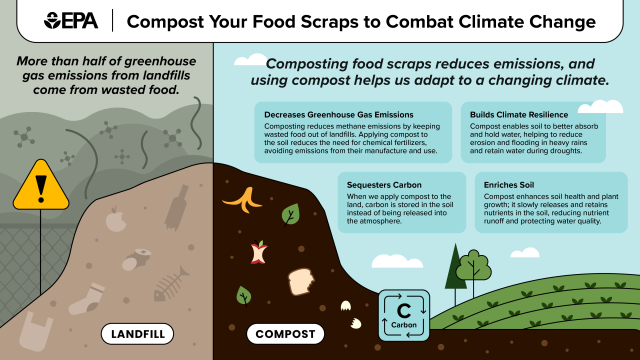Composting
On this page:
- EPA's Wasted Food Scale
- Impacts of Sending Food and Other Organic Materials to Landfills
- Definitions
- Composting Basics and Approaches
- Benefits of Composting
- Benefits of Using Compost
- Composting-Related Policies and Regulations
- Additional Resources
- Sources of Statistics
EPA's Wasted Food Scale

Composting is nature’s way of recycling and is one of the most powerful actions we can take to reduce trash in landfills and build healthy soil. Composting is in the fourth tier of EPA's Wasted Food Scale.
Impacts of Sending Food and Other Organic Materials to Landfills
In 2019, 66.2 million tons of wasted food were generated in the food retail, food service and residential sectors in the United States. Only 5% of that wasted food was composted.1
In the U.S., food is the single most common material sent to landfills, comprising 24.1 percent of municipal solid waste. When yard trimmings, wood and paper/paperboard are added to food, these organic materials comprise 51.4 percent of municipal solid waste in landfills.2
When food and other organic materials decompose in a landfill where anaerobic (without oxygen) conditions are present, bacteria break down the materials and generate methane, a powerful greenhouse gas. Municipal solid waste landfills are the third largest source of human-related methane emissions in the U.S, accounting for approximately 14% of methane emissions in 2022.3 Wasted food is responsible for 58% of landfill methane emissions.4
Composting is a form of organics recycling. Organics recycling is when facilities collect and process organic materials (that would otherwise be landfilled or incinerated) into new products, such as soil amendments. When we send food and other organic materials to landfills or combustion facilities, we throw away the valuable nutrients and carbon contained in those materials. By composting our food scraps and yard trimmings instead, and using the compost produced, we can return those nutrients and carbon to the soil to improve soil quality, support plant growth and build resilience in our local ecosystems and communities.
Composting is a fundamentally local process. Organic materials are typically collected and processed into compost near where they are generated, often in the same county, city or even neighborhood. In this way, composting also supports local jobs and economies.
Definitions
Composting is the managed, aerobic (oxygen-required) biological decomposition of organic materials by microorganisms. Organic (carbon-based) materials include grass clippings, leaves, yard and tree trimmings, food scraps, crop residues, animal manure and biosolids. Compost products for commercial sale typically go through thermophilic composting, where compost reaches high temperatures that reduce pathogens.
Compost is a biologically-stable soil amendment produced by the aerobic decomposition of organic materials.

Composting Basics and Approaches
Regardless of size or scale, the basic principles of composting are generally the same. The composting process requires a proper ratio of carbon-rich materials (such as dry leaves or wood chips) to nitrogen-rich materials (such as food scraps or grass clippings). Maintaining adequate moisture level, oxygen flow, particle size, and temperature ensures microorganisms effectively break down organic materials into quality compost.
The method of composting used, as well as the equipment, is often determined by the scale or size of the site and the volume and type of materials, or feedstocks, being composted. The feedstocks accepted vary by composting facility and should always be free of contaminants such as herbicides, non-compostable packaging, and produce stickers.
Composting can take place at many scales/sizes – backyard, community, on-farm, municipal and regional – and at a range of locations in urban to rural areas. A small-scale system can be as simple as a backyard compost pile or vermicomposting (worm composting) bin, whereas a large-scale system may be a centralized, commercial composting facility processing organic materials from around the region.
Learn more about the composting process as well as composting at home and community composting. Interested in starting a composting program in your area? Visit EPA's webpage of resources for help.
Benefits of Composting
- Protects the climate by reducing methane emissions from landfills.
- Reduces waste.
- Recycles organic materials into a valuable soil amendment – compost.
- Recovers nutrients in organic materials and provides an opportunity to keep them local.
- Creates green jobs.
- Extends municipal landfill life by diverting organic materials.
Benefits of Using Compost
Compost Enriches and Builds Healthy Soil
- Adds organic matter to the soil and increases the nutrient content and biodiversity of microbes in soil.
- Conserves water and reduces water use by helping soils retain moisture.
- Helps prevent soil erosion by reducing soil compaction and runoff.
- Reduces reliance on chemical fertilizers and pesticides.
- Improves plant growth and promotes higher yields of agricultural crops.
- Improves water quality by filtering stormwater and reducing nutrient and sediment runoff.
- Helps regenerate poor soil and remediate (clean up) soils that have been depleted by overuse or contain contaminants.
Compost Aids Climate Adaptation and Resilience
- Improves a community’s ability to adapt to adverse climate impacts by helping soil absorb water and prevent runoff of pollutants during floods. It also helps soil hold more water for longer, mitigating the effects of drought.
- Sequesters carbon in the soil, helping reduce greenhouse gas emissions.
- Strengthens sustainable, local food production when locally generated food scraps and other organic materials are used to create a valuable soil amendment that supports plant growth.
Markets and applications for compost include agriculture, horticulture, landscaping, gardening, topsoil and sod production, roadside and construction projects, wetlands protection and creation, soil remediation, land revitalization, sports fields and golf courses, ecosystem restoration, sediment and erosion control, and green infrastructure.
Learn more about the many benefits of using compost in different applications.

Composting Policies and Regulations
Composting policies and regulations are set at the state and local government level.
Some states ban or restrict landfill disposal of organic materials such as yard and tree trimmings and wasted food. Some bans only affect large generators of organic materials, whereas others affect all generators of wasted food, down to the household level.
Below are some composting and compost use policy resources:
- The Environmental Law Institute offers a Toolkit for Incorporating Food Waste in Municipal Climate Action Plans (Environmental Law Institute).
- The Institute for Local Self-Reliance has a guide for Healthy Soils and Compost Policy (pdf)(1.1 MB). They also maintain a list of different compost-related rules by state, and much more on its Compost Policy Resource Hub.
- The National Resources Defense Council and Environmental Law Institute showcase a Model Municipal Zoning Ordinance on Community Composting and a Model Policy for Compost Procurement.
- ReFED offers the U.S. Food Waste Policy Finder, a searchable tool of wasted food and organics recycling policies.
- The Sustainable Economies Law Center, in collaboration with the Institute for Local Self-Reliance, maintains a website on compost law and policy. The website focuses on community and small-scale composting.
- The U.S. Composting Council compiles information on state compost regulations, has a Model Compost Rules Template for States to use in updating their composting permitting regulations, and maintains a map of states’ organics bans.
- The Zero Food Waste Coalition provides a toolkit and template legislation on how to start the process of enacting an organics ban in your community.
Additional Resources
Visit the other EPA composting webpages for more information and resources:
- Approaches to Composting.
- Benefits of Using Compost.
- Community Composting.
- Composting at Home.
- Start a Composting Program.
Mention of or referral to commercial products or services or links to non-EPA sites does not imply official EPA endorsement of or responsibility for the opinions, ideas, data, or products presented at those locations or guarantee the validity of the information provided. Mention of commercial products/services on non-EPA websites is provided solely as a pointer to information on topics related to environmental protection that may be useful to EPA staff and the public.
Visit the webpages below for more composting information:
- EPA/USDA Composting Fact Sheet (pdf)(620 KB) | Composting Fact Sheet en Español (pdf)(882 KB) | Composting Fact Sheet (horizontal)(jpg)(489 KB).
- EPA Excess Food Opportunities Map.
- EPA Managing and Transforming Waste Streams Tool.
- EPA Recycling Infrastructure and Market Opportunities Map.
- EPA Compost Use Workshop for Specifications.
- EPA Success Stories in Reducing Waste.
- EPA Composting Food Scraps in Your Community: A Social Marketing Toolkit.
- EPA report on The Environmental Value of Applying Compost.
- EPA reports on Emerging Issues in Food Waste Management: Persistent Chemical Contaminants (pdf) (3.2 MB); Plastic Contamination (pdf) (2.7 MB); Commercial Pre-Processing Technologies (pdf) (3.5 MB).
- BioCycle, an industry resource on composting.
- Compost Research and Education Foundation.
- Institute for Local Self-Reliance.
- Target Organics – A Compost Program Resources Hub.
- U.S. Composting Council.
- Cornell Waste Management Institute.
- COOL-Now.



